In a previous post (https://www.thefirearmblog.com/blog/2017/02/21/weapons-rios-crime-war/), TFB showed some of the weapons in use by criminals in Rio de Janeiro’s crime war, which demonstrated an apparent unlimited quantity and variety of guns available to the outlaws. On the other side of the conflict, as previously stated, the first line of defense rests in the hands of PMERJ – Polícia Militar do Estado do Rio de Janeiro (Rio de Janeiro State Military Police), whose limited resources, both human and material, are somewhat compensated by the idealism clearly stamped on its members when in action. The tough urban warfare scenarios present in Brazil’s most popular city are hard to describe to anyone just sitting in front of a computer screen. Anyway, the pictures that follow, most of them of actual operations, may give you an idea of what’s going on there (here, in author’s case).
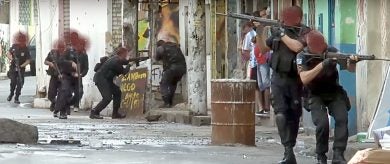
Although there’s not such a thing as a “typical” urban warfare scenario in Rio, this image shows what PMERJ troops (here with 7.62x51mm FALs and Para-FALs) of a standard battalion have to deal with more often than not: narrow streets and civilians walking around. The concrete-filled fuel drum on the right is an anti-vehicle obstacle planted by criminals.

Street search of a suspect motorbiker by a trooper of BPChq – Batalhão de Polícia de Choque (Shock Police Battalion) shows a .40S&W Famae-Taurus MT40 submachine gun – small numbers in use – while the holstered pistol appears to be a Taurus Series 800 in the same caliber.

Picture shows the same subgun model in use by a member of a standard military police battalion. The Famae-Taurus agreement has for long come to an end.
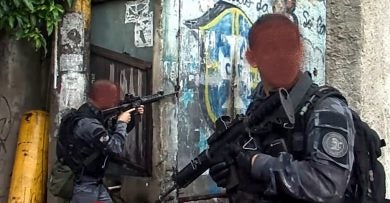
The 7.62x51mm Armalite AR-10A4 rifle fitted with an EOTech sight is in current use by three specialized battalions of Rio’s Military Police, the BOPE – Batalhão de Operações Policiais Especiais (Special Police Operations Battalion), the BAC – Batalhão de Ações com Cães (Dog Actions Battalion), and the BPChq – Batalhão de Polícia de Choque (Shock Police Battalion).

The Armalite rifle also finds use with the GAM – Grupamento Aeromóvel (Airmobile Group), the rotary wing unit.

This particular BPChq AR-10A4 has been fitted with a scope, while the actual sniper variant (the AR-10 SuperSASS) is in use by the BOPE unit.
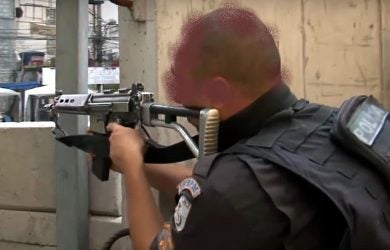
This trooper taking a firing position is using a 5.56x45mm Imbel MD-97LC, a rifle that started life merely as a FAL in a different caliber but ended up being a new weapon in its own, featuring a rotary-bolt in its gas-action system, for example. Weapon is still widely deployed.
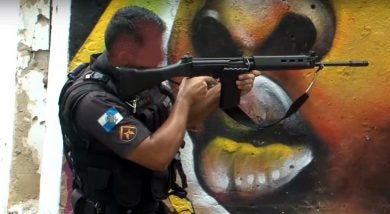
The 7.62x51mm FAL (most f them locally made by Imbel) is pretty much used by PMERJ in different fashions, i.e., solid stock, foldable stock, long barrel, short barrel, etc. Substantial numbers have been donated by Brazilian Navy’s CFN -Corpo de Fuzileiros Navais, the Marine Corps.
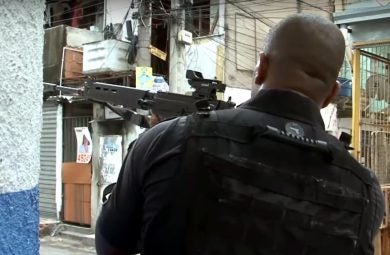
This Para-FAL has received a top Picatinny rail to which the operator added a reflex sight of probable individual ownership (can you ID it?).


A weapon’s flexibility put to good, expedient use: when a bad guy is known to be in a hidden position, why not use a riot-type grenade launcher (here, a locally-made Condor AM 637 for 37/38mm rounds) to force him out? Weapon is occasionally seen carried by PMERJ in urban combat operations. Just in case…
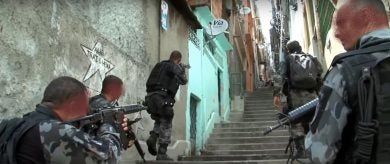
Side-by-side use of two 5.56x45mm carbines in Rio, the Imbel MD-97LC (left) and the Colt M16A2 Commando. Commonly found in poorer urban regions, narrow paths for troops to progress in densely built-up and populated areas are a nightmare in police operations.
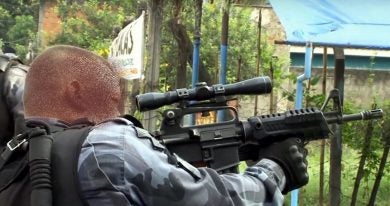
Field adaptations are seen here and there, as in the case of this M16A2 Commando fitted with a scope and a vertical foregrip adaptor.

This MD-97LC has also received a “dynamic duo”, scope and vertical foregrip (folded forward, in pic).

This sergeant apparently brought his own 12-ga shotgun to work, a Turkish-made semi-auto Hatsan Escort Raider to which he added a red-dot sight.

A PMERJ corporal ready to advance into unknown ground trusting his old reliable Madsen M1932 light machine gun. Originally in 7x57mm Mauser caliber, these former Brazilian Army guns were later modified by Imbel’s Fábrica de Itajubá (Itajubá Factory) to use 7.62x51mm ammo. Top-fitted magazine holds 30 rounds and is offset to the left of gun.
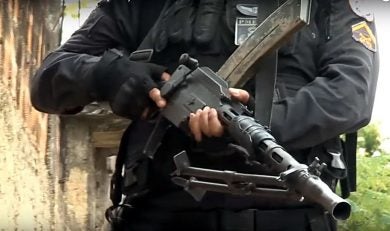
Closer view of another veteran Danish light machine gun still in action in Rio’s drug war. This example keeps its original foldable bipod, an expedient rubber (from tire tube!) hand protection having been tied with wire to the barrel shroud. Also note the large cocking handle and the ejection port cover open.
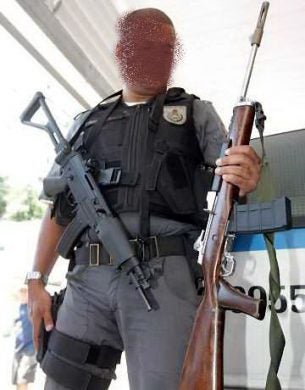
This trooper holding a captured 5.56x45mm Ruger Mini-14 (with an added-on pistol grip) is armed with a .30 Carbine-caliber Famae-Taurus CT-30. When introduced into large-scale service in 2009-2010, the guns presented a number of problems, which resulted in most of the 1,550 examples acquired being sent back to the manufacturer, for good. A few serviceable carbines remain in use, though, for which a vast stock of locally-made ammo (CBC) is still available.

CT-30 carbines in use by PMERJ in action in November, 2010.
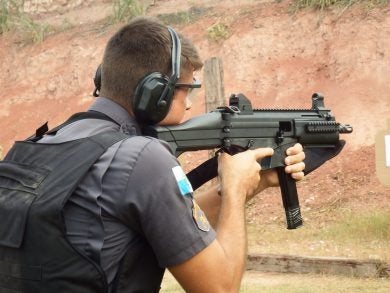
A recent addition to Rio’s Military Police inventory is the .40S&W Taurus CTT40C semi-auto carbine, basically used in UPPs – Unidades de Polícia Pacificadora (Pacifying Police Units) working in lower-conflict areas.
 Your Privacy Choices
Your Privacy Choices
